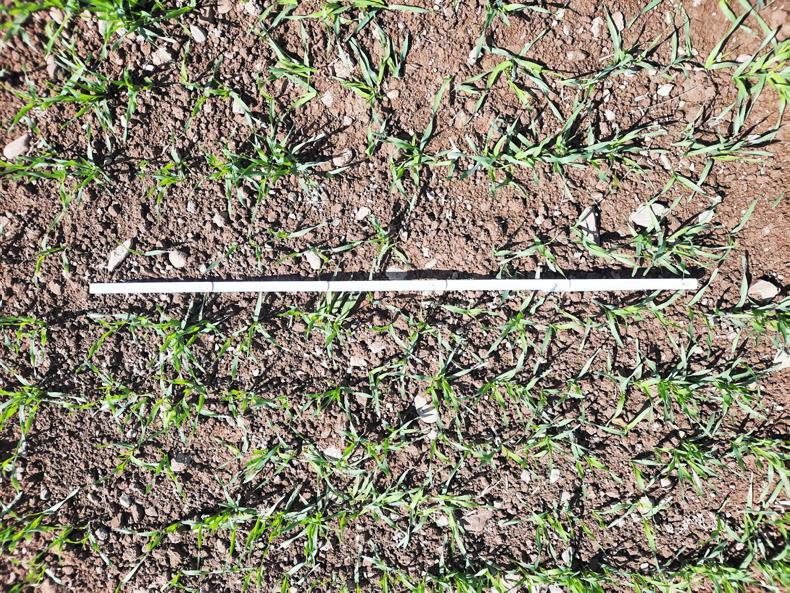Across the Footprint Farms at present, the tillage farmers have planted and some are finishing off spring planting.
As crops come up, it’s important to determine how successful establishment was. This can help to manage agronomy during the year.
For example, if establishment is poor, inputs may be altered. In years where winter crops are poor, this can sometimes determine if a reseed is needed, but this would be an extreme measure.
Other advantages of taking a plant count, particularly in the spring, are to see if the seed drill worked correctly, to examine under-performing parts of a field and to get an establishment percentage.
Calculating an establishment percentage can help to examine if sowing conditions were appropriate and what can be done next season in order to improve plant count numbers.
Maybe a higher seed rate would have been more appropriate at the time of planting.
Plant counts are easiest to carry out when plants are at the one- to two-leaf stage. If plants start to tiller out, it becomes very difficult to count them.
How to carry
out a plant
count
You will need a quadrat, a metre stick or a measuring tape to carry out plant counts. A quadrat will be a specific size, eg 0.25m2 or 0.2m2, depending on the length of the sides of the square.

Taking plant counts along one side of a row of barley using a metre stick.
A stick or measuring tape can be measured to 1m and used to count along a row of plants. Throw the quadrat randomly across different parts of the field.
Count how many plants are in the square and multiply this number to calculate 1m2. For example, if the quadrat is 0.25m2 in size then it should be multiplied by four to get the number of plants/m2.
If using a metre stick throw the stick randomly across the field. Line the stick along a row of plants and count the plants along the side of the stick.

Counting the number of rows of barley across one metre. Seed drills will differ.
You then need to put the metre stick across the rows of plants to count the number of rows in 1m. This figure will vary with different drills. You then multiply the number of plants along 1m by the number of rows in 1m to get the number of plants/m2.
What should the target plant population be?
In general, Teagasc recommends a seeding rate of 350 seeds/m2 to establish 300 plants/m2. That equates to an establishment rate of approximately 85%.
Later-sown crops, planted in April or so will most likely have a higher establishment rate than those planted in March. Winter wheat and barley crops should have a plant population of 250 to 300 plants/m2. Winter oats have a target plant population of 350 to 400 seeds/m2.
Across the Footprint Farms at present, the tillage farmers have planted and some are finishing off spring planting.
As crops come up, it’s important to determine how successful establishment was. This can help to manage agronomy during the year.
For example, if establishment is poor, inputs may be altered. In years where winter crops are poor, this can sometimes determine if a reseed is needed, but this would be an extreme measure.
Other advantages of taking a plant count, particularly in the spring, are to see if the seed drill worked correctly, to examine under-performing parts of a field and to get an establishment percentage.
Calculating an establishment percentage can help to examine if sowing conditions were appropriate and what can be done next season in order to improve plant count numbers.
Maybe a higher seed rate would have been more appropriate at the time of planting.
Plant counts are easiest to carry out when plants are at the one- to two-leaf stage. If plants start to tiller out, it becomes very difficult to count them.
How to carry
out a plant
count
You will need a quadrat, a metre stick or a measuring tape to carry out plant counts. A quadrat will be a specific size, eg 0.25m2 or 0.2m2, depending on the length of the sides of the square.

Taking plant counts along one side of a row of barley using a metre stick.
A stick or measuring tape can be measured to 1m and used to count along a row of plants. Throw the quadrat randomly across different parts of the field.
Count how many plants are in the square and multiply this number to calculate 1m2. For example, if the quadrat is 0.25m2 in size then it should be multiplied by four to get the number of plants/m2.
If using a metre stick throw the stick randomly across the field. Line the stick along a row of plants and count the plants along the side of the stick.

Counting the number of rows of barley across one metre. Seed drills will differ.
You then need to put the metre stick across the rows of plants to count the number of rows in 1m. This figure will vary with different drills. You then multiply the number of plants along 1m by the number of rows in 1m to get the number of plants/m2.
What should the target plant population be?
In general, Teagasc recommends a seeding rate of 350 seeds/m2 to establish 300 plants/m2. That equates to an establishment rate of approximately 85%.
Later-sown crops, planted in April or so will most likely have a higher establishment rate than those planted in March. Winter wheat and barley crops should have a plant population of 250 to 300 plants/m2. Winter oats have a target plant population of 350 to 400 seeds/m2.








 This is a subscriber-only article
This is a subscriber-only article










SHARING OPTIONS: